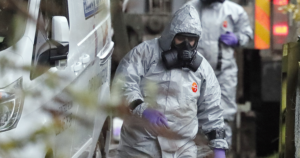John A. Gilbert, Scientists Working Group on Biological and Chemical Security
 Once again, the world is learning about another case of death and profound harm from exposure to chemical weapon (CW) material. On Saturday, June 29, two civilians living a few miles from Salisbury, England were hospitalized after exposure to a nerve agent; one died and the other is in critical condition as of July 9. The UK government has announced that the nerve agent found in this case is the same as was used in the March assassination attempt against a former Russian intelligence officer and his daughter. Although the exact method of exposure in this latest case is not yet known, one well-supported theory is that the individuals found materials left behind by the March assassins and were inadvertently exposed as a result. The chemical in both these cases is one of the “novichok” family of nerve agents, which were uniquely and solely developed by the former Soviet Union in laboratories in Russia. Although the chemical formulas for novichok agents are known, no other nation has produced any of these agents.
Once again, the world is learning about another case of death and profound harm from exposure to chemical weapon (CW) material. On Saturday, June 29, two civilians living a few miles from Salisbury, England were hospitalized after exposure to a nerve agent; one died and the other is in critical condition as of July 9. The UK government has announced that the nerve agent found in this case is the same as was used in the March assassination attempt against a former Russian intelligence officer and his daughter. Although the exact method of exposure in this latest case is not yet known, one well-supported theory is that the individuals found materials left behind by the March assassins and were inadvertently exposed as a result. The chemical in both these cases is one of the “novichok” family of nerve agents, which were uniquely and solely developed by the former Soviet Union in laboratories in Russia. Although the chemical formulas for novichok agents are known, no other nation has produced any of these agents.
This is the most recent in a series of attacks that have taken place in the past two years. For example, in February 2017, Kim Jong-un’s half-brother was assassinated at a Malaysian airport by two women who used a binary form of the nerve agent VX. A hospital in Latamneh, Syria was attacked by “barrel bombs” filled with chlorine (a choking agent first used as a CW in World War I) on March 25, 2017 resulting in the death of a doctor and a surgical patient. This was followed by a sarin attack against Latamneh on March 30, 2017, which caused more than 70 casualties but no deaths, due to rapid medical response. On April 4, 2017, a sarin attack killed more than 80 civilians in the Syrian city of Khan Sheikhun. This April attack prompted a U.S. cruise missile strike on the Syrian airfield from which the attack aircraft had taken off and to which it returned. Tragically, on April 7, 2018 at least 50 civilians in the Damascus suburb of Douma were killed and others injured by yet another chlorine “barrel bomb” attack (and possibly by the nerve agent sarin, which may also have been used in small amounts). Although the United States conducted several cruise missile strikes against known Syrian CW facilities, Syria and its Russian and Iranian enablers have all denied responsibility for that attack.
The Organization for the Prohibition of Chemical Weapons (OPCW), which is the implementing body for the CWC, conducted UN-mandated investigations of sarin and chlorine use in Syria, and provided hundreds of pages of evidence, but was blocked from attributing “guilt” by the limitations of its mandate. However, the evidence points in only one direction — that Syria, likely aided by Russia, conducted the 2013 and 2017 sarin attacks and multiple chlorine attacks, including one on April 7, 2018.
In the face of these continuing attacks, effective action has still not been taken by the international community. Although the OPCW Conference of States Parties voted overwhelmingly in June to move to attribute responsibility for future CW use that vote was the start of a process that may take months to years to be fully effective.
The March assassination attempt in Salisbury led to diplomatic action by the UK government, the United States, and several other nations. Although this latest incident may be a consequence of the earlier attack and not a new act by Russia, it is an escalation and points out the lingering danger of uncontrolled and misused CW. This month’s NATO summit and a planned one-on-one talk between President of the United States Donald Trump and Russian President Vladimir Putin provide an excellent opportunity to send a strong message to Russia and its allies that CW use has consequences. People will be watching to see what happens, particularly any positive result of the U.S.-Russian heads of state meeting…
